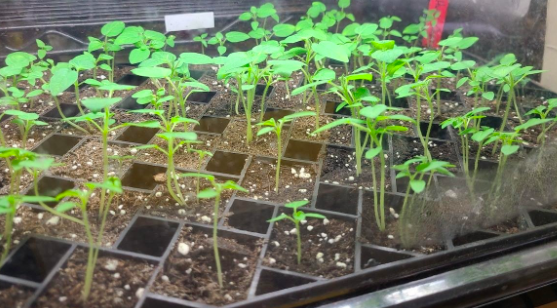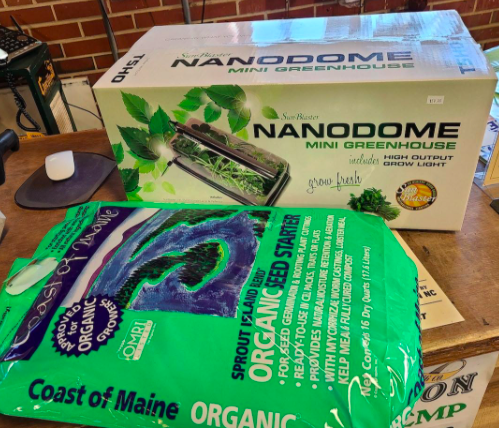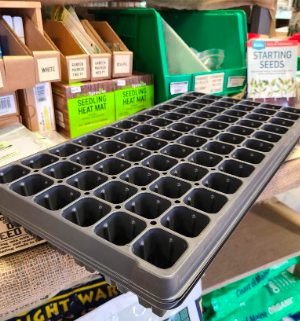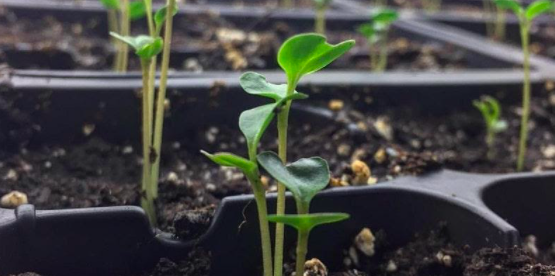
-Dan Toot-
It can’t be April again! It’s STILL April! (March 413th as of the time of this writing.) Still, the wonderful deja vu of this time of year is seeing the rush to the seed rack and our soil amendments as gardeners prepare for a great year of growing. Seeing this, I decided it was time to join the fun and start plants from seed myself!
If you dig back, you’ll see I first dipped my toe into organic gardening with some Golden Ghost Pepper seedlings — which I cloned and am continuing to grow in a deep water culture here at the Carrboro shop. Stay tuned for more on that! But now I’m back in the dirt to see what a hobby gardener with limited space can learn by growing from seed.
This Here is For All My Apartment Gardeners!
It’s been a year of quarantine. You’ve tried sourdough; you’ve got your kombucha going; you’ve even started homebrewing and winemaking. The point is, this equipment can accumulate. So how do we make efficient use of space? We’re lucky at the shop to have sophisticated lighting and high-quality grow tents, but in addition to a financial investment, it’s a physical investment we may not all have room for. So what can a gardener with a small living space do?

Enter the Nanodome: A handy little tray/light/humidome setup ideally suited to a small space and smaller gardens. If you’ve got a 10”x20” space, you’ve got room for a tray of happy seedlings. You’ll see here, I’ve decided to give Ground Cherries a shot, after seeing them ad nauseam while binging The Great British Baking Show (where they’re adorably called Gooseb’ries) A cousin of the tomato, they behave in much the same way, so you can branch into some newer flavor territory and still make use of the reliable gardening techniques you’ve already developed.
Setting Up for the Party

To go in the Nanodome, and make the most efficient use of that space, I decided to opt for our 72-cell tray insert. I’d be remiss if I didn’t also recommend, when considering which insert to use, to have an eye toward sustainability. Many seed-starting trays are flimsy and meant to be used only one time. Our solid 72 cell tray is a great option as it provides many sites for your seeds to get a good start, and can still be re-used when treated carefully.
So. Tray, Insert, Nanodome, now what do we put the seeds in? Here in Carrboro, we just started carrying Coast of Maine products, including their Sprout Island Seed Starter. This seemed like a great opportunity to give it a shot. With any seed starting/seedling mix, you don’t want anything too “hot” (loaded with nutrients) as it will easily overwhelm and “burn” a young plant. The Coast of Maine mix is great as it includes a rich mix of aged compost and worm castings, as well as kelp meal and mycorrhizae to help the young plant establish a robust root system. Plus, I’m pleased to say, it retains moisture well, with the added help of the humidome.
At this point we’re ready to prepare our tray. Simply spread the seedling mix over the tray insert, making sure an adequate amount fills each cell. Periodically tap the tray against the table shake loose any excess soil, and repeat as necessary until each cell has even coverage without packing the soil down. Then prepare your seeds and sow according to whatever they prefer! Welcome them home with a bit of water, but take care not to over-saturate as seeds are notoriously bad swimmers.
Do As I Say…
At this point, you’re off and running! Monitor moisture, taking care to keep everything nice and moist. To avoid washing out my hard work, I took to thoroughly spraying down the surface of the soil, rather than watering from a can which seemed to yield a positive result. I wasn’t always full of great ideas, however, and I’m here to make the mistakes so you don’t have to. You may want to keep these things in mind:
- pH adjust your water, as needed – we have a nice big rain barrel here at the shop that we use for much of our watering needs. Typically rainwater may come out slightly more acidic than neutral, but what I hadn’t realized is that, because of our gravel roof, the water can come out of the barrel with a VERY high pH. Almost 9! If you’re unfamiliar with the pH of the water you’re going to use, it’s a great idea to get a quick read on it just to know what you’re working with.
- You may have been suggested nutrients like fish emulsion and/or Seaweed extract to feed your plants. These are great nutritional sources for young plants, but fellow apartment gardeners beware! They can smell something FIERCE. Save your relationships with members of your pod, significant others, roommates, and work with fertilizers outside.
- Stimulate your young plants! When they’ve reached a healthy size, consider a fan or even a little combing over with your hand periodically. This is how young plants can build tensile strength which makes for sturdier transplants later on. That’s right, you can literally pet your seedlings!
So we’re off! Starting from seed in a space-efficient, time-efficient, budget-efficient way. Maybe you’ve had some balcony tomatoes doing well and you want to kick it up a notch, or maybe you’re just a houseplant lover who wants to get a little more hands-on with the growing process. Whatever skill level, seed starting can be a low-cost, high-reward way to engage in a little hands-on horticultural education.


Leave a Reply